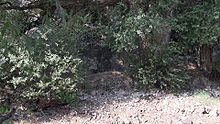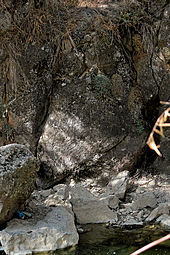Taşçı rock reliefs
Coordinates: 38 ° 11 ′ 55.5 ″ N , 35 ° 46 ′ 52 ″ E
The two rock reliefs from Taşçı date from the time of the Hittite Empire. They are located about two kilometers south of the village of Taşçı in the Develi district of the Turkish province of Kayseri . They are called in Turkish as Yazılı Kaya ("described rock").
location
In the village of Taşçı, the Şamaz Dere, also called Homur Suyu, which rises on Bakırdağ to the south, flows into the Zamantı Irmağı. At the point where it breaks through between two closely spaced rock ridges, the two reliefs labeled Taşçı A and B are less than a hundred meters apart on the western bank. At the time when the sculptures were created, there was certainly no road running along the narrow passage, and parts of the rock had to be blasted to create the modern road. The location on the water and the caves above the reliefs suggest a cultic function of the place.
Taşçı A
The northern of the two reliefs, Taşçı A, lies one to two meters above the river, depending on the water level, and now only protrudes less than a meter from the alluvial soil. It shows three figures turned to the right at the bottom right, who have disappeared above waist level in the alluvial land. Their outlines are covered with deep grooves. The one on the left is best preserved so that the interior drawing can still be seen on it. Ribbons run over the head, a scarf hangs down over the back, which identifies this figure as feminine. The eyes and chin are still visible, the mouth and nose in between has broken out. One arm of each of the two people on the left is stretched out; after the drawing by Ignace Gelb in 1939, the figure on the right had the same posture, which, however, can no longer be seen due to the severe weathering. Only the contours of the two figures on the right, who are wearing round caps, are left. All three are generally considered to be priests.
Above the heads there are inscriptions in Luwian hieroglyphs , whereby the figures on the left can each be assigned a group of symbols, while the figure on the right has not been preserved. The reading is difficult because of the poor condition. Only the name of the left, female figure can be interpreted as Ma-na-a-za / i , she is further referred to as the daughter of Lubakki, the son of the army clerk . Another hieroglyphic group is to the left of the three, it names another person, after JD Hawkins the bodyguard Zida, servant of Hattušili , the great king, the hero. Since this is not shown, it may be the donor of the relief.
Taşçı B
Less than 100 meters upstream, directly on the bank or at a higher water level in the river, on a single boulder, is the relief Taşçı B. The incised relief shows a male figure facing to the right. She wears a round cap with a horn at the front, the long robe of the priest and a shawl that hangs over her shoulder and arm. The right arm is raised in greeting, the left one stretched out. Above this, the sign of salvation, actually reserved for gods, can be seen. Three hieroglyphs seen under the arms were read differently by different researchers, but the name could not be inferred.
meaning
Above Taşçı A there is a cave in the rock wall, from which a shaft leads down vertically. Today it is filled with washed-in earth, but possibly reached to the surface of the water. In the wall behind Taşçı B there is also a cave, from which a shaft also leads downwards. Both caverns and the location on the water indicate the place's cultic significance. The orientation of the priestly figures downstream in the direction of the cultivated fields in the river plain suggests that they should exercise a protective function for the local agriculture and for a possibly existing place.
According to the inscriptions, the reliefs date to around the 13th century BC. Dated.
Research history
The first short reports and the first reading on Taşçı A were published by Hans Rott and Leopold Messerschmidt after Rott's Anatolia trip in 1906 , and by Guillaume de Jerphanion in the same year . Ignace Gelb excavated the lower part of the relief in 1935 and published a copy and a photograph. Taşçı B was first described by Sedat Alp and Ekrem Akurgal in 1947 . Then in 1954 Hans Gustav Güterbock visited the place. Piero Meriggi presented the first detailed report on both rock art in 1975 after his first trip to Anatolia. His treatment of the inscriptions almost coincided with that of Gelb, in contrast to that of Franz Steinherr from the same year. The latter was taken over by Markus Wäfler . Kay Kohlmeyer provided a comprehensive review in 1983, and Horst Ehringhaus finally published a description of the reliefs in 2003.
literature
- Kay Kohlmeyer: Rock paintings from the Hittite Empire. In: Acta Praehistorica et Archaeologica 15 (1983) pp. 74-80.
- Horst Ehringhaus: gods, rulers, inscriptions. The rock reliefs of the Hittite Empire in Turkey. Zabern, Mainz 2005, ISBN 3-8053-3469-9 , pp. 65-70.






